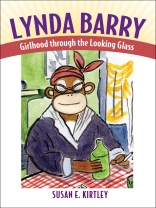Best known for her long-running comic strip
Ernie Pook’s Comeek, illustrated fiction (
Cruddy, The Good Times Are Killing Me), and graphic novels (
One! Hundred! Demons!), the art of Lynda Barry (b. 1956) has branched out to incorporate plays, paintings, radio commentary, and lectures. With a combination of simple, raw drawings and mature, eloquent text, Barry’s oeuvre blurs the boundaries between fiction and memoir, comics and literary fiction, and fantasy and reality. Her recent volumes
What It Is (2008) and
Picture This (2010) fuse autobiography, teaching guide, sketchbook, and cartooning into coherent visions.
In
Lynda Barry: Girlhood through the Looking Glass, author Susan E. Kirtley examines the artist’s career and contributions to the field of comic art and beyond. The study specifically concentrates on Barry’s recurring focus on figures of young girls, in a variety of mediums and genres. Barry follows the image of the girl through several lenses—from text-based novels to the hybrid blending of text and image in comic art, to art shows and coloring books. In tracing Barry’s aesthetic and intellectual development, Kirtley reveals Barry’s work to be groundbreaking in its understanding of femininity and feminism.
लेखक के बारे में
Susan E. Kirtley is professor of English, director of composition, and director of comics studies at Portland State University. She is winner of the 2013 Eisner Award for Best Educational/Academic Work for her book Lynda Barry: Girlhood through the Looking Glass and coeditor (with Antero Garcia and Peter E. Carlson) of With Great Power Comes Great Pedagogy: Teaching, Learning, and Comics, both published by University Press of Mississippi.












